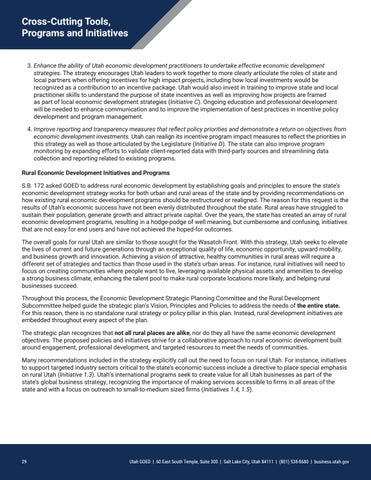Cross-Cutting Tools, Programs and Initiatives 3. Enhance the ability of Utah economic development practitioners to undertake effective economic development strategies. The strategy encourages Utah leaders to work together to more clearly articulate the roles of state and local partners when offering incentives for high impact projects, including how local investments would be recognized as a contribution to an incentive package. Utah would also invest in training to improve state and local practitioner skills to understand the purpose of state incentives as well as improving how projects are framed as part of local economic development strategies (Initiative C). Ongoing education and professional development will be needed to enhance communication and to improve the implementation of best practices in incentive policy development and program management. 4. Improve reporting and transparency measures that reflect policy priorities and demonstrate a return on objectives from economic development investments. Utah can realign its incentive program impact measures to reflect the priorities in this strategy as well as those articulated by the Legislature (Initiative D). The state can also improve program monitoring by expanding efforts to validate client-reported data with third-party sources and streamlining data collection and reporting related to existing programs. Rural Economic Development Initiatives and Programs S.B. 172 asked GOED to address rural economic development by establishing goals and principles to ensure the state’s economic development strategy works for both urban and rural areas of the state and by providing recommendations on how existing rural economic development programs should be restructured or realigned. The reason for this request is the results of Utah’s economic success have not been evenly distributed throughout the state. Rural areas have struggled to sustain their population, generate growth and attract private capital. Over the years, the state has created an array of rural economic development programs, resulting in a hodge-podge of well meaning, but cumbersome and confusing, initiatives that are not easy for end users and have not achieved the hoped-for outcomes. The overall goals for rural Utah are similar to those sought for the Wasatch Front. With this strategy, Utah seeks to elevate the lives of current and future generations through an exceptional quality of life, economic opportunity, upward mobility, and business growth and innovation. Achieving a vision of attractive, healthy communities in rural areas will require a different set of strategies and tactics than those used in the state’s urban areas. For instance, rural initiatives will need to focus on creating communities where people want to live, leveraging available physical assets and amenities to develop a strong business climate, enhancing the talent pool to make rural corporate locations more likely, and helping rural businesses succeed. Throughout this process, the Economic Development Strategic Planning Committee and the Rural Development Subcommittee helped guide the strategic plan’s Vision, Principles and Policies to address the needs of the entire state. For this reason, there is no standalone rural strategy or policy pillar in this plan. Instead, rural development initiatives are embedded throughout every aspect of the plan. The strategic plan recognizes that not all rural places are alike, nor do they all have the same economic development objectives. The proposed policies and initiatives strive for a collaborative approach to rural economic development built around engagement, professional development, and targeted resources to meet the needs of communities. Many recommendations included in the strategy explicitly call out the need to focus on rural Utah. For instance, initiatives to support targeted industry sectors critical to the state’s economic success include a directive to place special emphasis on rural Utah (Initiative 1.3). Utah’s international programs seek to create value for all Utah businesses as part of the state’s global business strategy, recognizing the importance of making services accessible to firms in all areas of the state and with a focus on outreach to small-to-medium sized firms (Initiatives 1.4, 1.5).
29
Utah GOED | 60 East South Temple, Suite 300 | Salt Lake City, Utah 84111 | (801) 538-8680 | business.utah.gov











